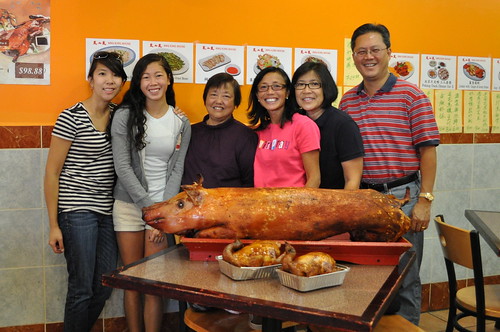--Gael Greene, on Patricia Wells' The Food Lover's Guide to Paris, 1984
from New York Magazine article (Vol. 17, No. 26), 6.25.1984.
Friday, October 29, 2010
Food for Thought | Gael Greene
“To be tempted and indulged by the city's most brilliant chefs. It's the dream of every one of us in love with food.”
Monday, October 25, 2010
Etcetera | hiatus from morsel marauding
I know I've been MIA the last week or so--things in the bean-counting world are starting to pick up, unfortunately. I hope to have 2-3 new posts by the end of the week (lots to say about my mind-blowing visit to Alinea)! So much to share, so little time! But no worries--I'll be back before you know it! But until then, I'll leave you with this:
“There is no love sincerer than the love of food.”
--George Bernard Shaw
from Man and Superman, 1903.
Friday, October 22, 2010
Food for Thought | David Kinch
“Food is ephemeral. It becomes a memory after you eat it. It should provokes thought and make you learn something.”
--David Kinch
Saturday, October 16, 2010
Lunch | Gramercy Tavern
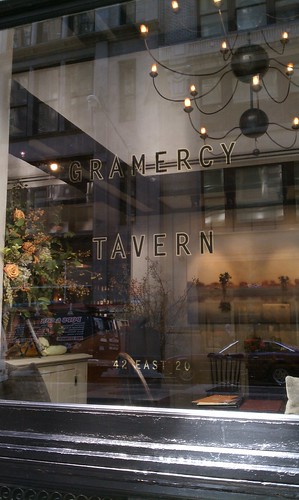
I decided to have a relaxing lunch at Gramercy Tavern during a personal day I had taken to help out my grandparents in Brooklyn with errands. I've been meaning to make a stop here for the longest time ever since Derek had told me about it a few years ago, so I'm glad I finally made time for it (even if it was dinner that I had originally thought about).
For the longest time, it used to be so awkward for me to say to the mâitre d', "Table for one, please." I had gotten over it around the time I traveled to Hong Kong for an internship where it was just me, solo, for four weeks. There was no way that I was going to miss out on all of the gastronomic goodness that Hong Kong had to offer, so I had a lot of practice during those four weeks of eating alone.

View from my "table for one" at Gramercy Tavern. I probably should've eaten in the bar area of the dining room, where it was less dark and intimate, but before I could say anything, the mâitre d' had already walked me to my table. Oh well.
The interior was filled with old American antiques (very tavern-esque) and lit by glowing candles and copper sconces (seen in photo above).
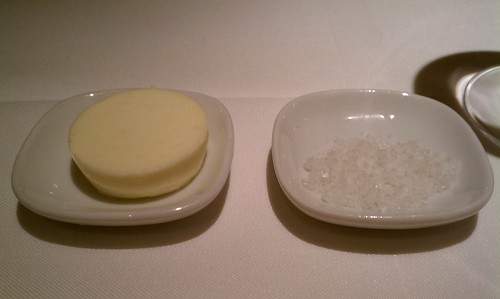
Butter and sea salt accompanied the bread that afternoon. I found this to be a really great combination--I had never been to a restaurant that served butter with salt before! Why have salted butter when you can have creamy, unsalted butter with some sea salt sprinkled on top? Yum!

The restaurant started out my two-course lunch with a series of the three amuse-bouches. The first was a beet and watermelon salad with hazelnuts and blue cheese, followed by a fairytale eggplant with some kind of confit (I missed that part) and crab salad, ending with a chilled pea soup. Beets, eggplant, and chilled soups aren't really my thing, but I promised myself, upon starting this blog, that I'd be more open to trying new things as well as old things that I've always found to be "ehhh" or repulsive. The first salad was pretty edible, except I thought it was slightly drowned too much by the beets. The crab salad was great. I tried a little with the fairytale eggplant (how cute, right?!), and I still wasn't feeling the combination. The chilled soup wasn't horrible, but I'm still a firm believer that soups should be served hot.

As my appetizer, I started with a calamari and carrot salad with toasted pine nuts and preserved lemon vinaigrette. I can't say this loudly enough--this was AMAZING! The combination of moistness (carrots), a dry crunch (toasted pine nuts), freshness (lemon from vinaigrette) and tender texture (calamari) made for salad so reminiscent of summer flavors. It was so subtle that it was easy to eat. Come to think of it, I finished really quickly. If I ever want to make a salad for a party or for lunch--this would be something that I would love to try to re-create. Solid success if executed properly!

I ordered the pork croquette with summer squash and farro. I guess during the time of my visit, fall was still coming around the corner, so it was nice to see the last remnants of summer ingredients in this dish as well as the salad. The bed of summer squash and farro was nicely done--the sauce may have been slightly much, but it worked well with the crispy outer shell of the pork croquette, which was battered very lightly. The pork interior was delicious, too. There may have been a little too much pork, and not enough outer shell, for the ratio of vegetable-grain-protein-batter to be optimized at its best.
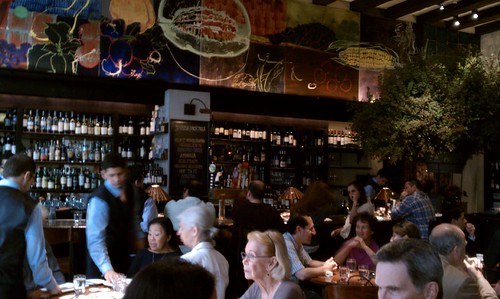
"Tavern" area of the restaurant. I like that there's a lot of natural light coming in from the windows here--it would make for nicely lit photographs.
Findings: I think the lunch prices are reasonable for what is served, though for lunch, the price point is slightly high. I think Gramercy Tavern would make a great place for business lunches and for taking out-of-town guests. I absolutely loved the salad--I would instantly go back for that if I were ever permitted to have an actual lunch break that didn't involve me eating at my desk. If lunch were served on the weekend, a glass of white wine would go great also. The croquette was prepared very well, but the salad definitely wins for this course. Another thing I'd like to address is the impeccable service I received during this lunch. Even at lunch, service is not compromised one bit (I assume dinner service just as precise and hospitable). I would love to go back for dinner to compare the two experiences. I'm sure I'll be able to find someone who's up for a dinner visit in the near future! :D
Price point: $14 for appetizer; $18 for entrée.
--September 21, 2010
Gramercy Tavern
42 East 20th Street
New York, NY 10003
http://www.gramercytavern.com/
Friday, October 15, 2010
Food for Thought | Thomas Keller
“If I have to be a brand… I am determined to be Hermès.”
--Thomas Keller, on branding
from Newsweek article "Kitchen Monumental: How Thomas Keller Transformed American Dining", 9.14.2010.
Dinner | 15 East
Two weeks ago, I took Marcus to 15 East near Union Square for his birthday. I tried to keep it a surprise, but Marcus somehow figured it out (he's quite impatient, you see). As a contingency for me revealing where I'd be taking him for his birthday, I told him I would need to have full control of what we'd order for dinner that night. Marcus didn't seem to mind.
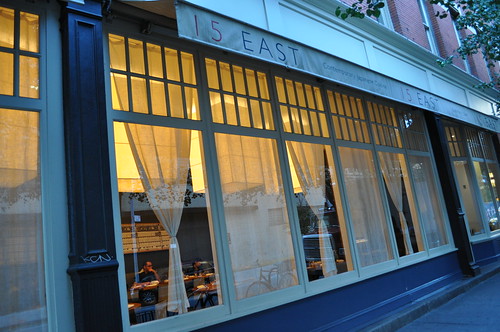
Restaurant owners Marco Moreira and Jo-Ann Makovitzky came up with the concept of 15 East as a restaurant that "serves contemporary Japanese cuisine and traditional sushi in an elegant and comfortable setting." With a long history of experience and interest in Japanese cuisine from Sao Paulo, Brazil to New York City, Mr. Moreira's main focus for 15 East is "seasonality, unusual ingredients, and unique flavor and textural combinations."
I've recently started getting into trying Japanese restaurants in the city that specialize in its sashimi/sushi offerings (e.g., Sushi Yasuda, Tomoe Sushi, etc.). Having grown up in a small town in Jersey, the local Japanese restaurants were mostly acceptable (some became my regular stops during my cravings for Japanese food), others were never frequented again after a visit or two. For that reason, the variety of fish offered at sushi bars was very limited. Though, one of the few exceptions I've come across in Jersey that offers very authentic Japanese cuisine and has a vast variety of fish flown in from Japan weekly is Jo-Sho, a modest little Japanese restaurant located in Somerset, owned by a Japanese couple--the husband is the sushi chef, the wife the general manager. What my mom likes to say is if you see Japanese families eating at a Japanese restaurant, that's when you know there will be excellent Japanese food--which is the case with Jo-Sho. It wouldn't be out of the ordinary to hear and witness many exchanges of conversation in Japanese between patrons and the owners.
With the issue of limited selection in mind, ordering omakase (chef's choice menu) seems very farfetched when the menus were so limited to begin with, so it had never really occurred to me to ever order that way. I played around with the idea of omakase when I read Frank Bruni's restaurant review of his revisit to Sushi Yasuda. I experienced my first omakase meal during my visit to Sushi Yasuda last December with my best friend, Lisa. I knew from then on out that in order to experience the smorgasbord of raw fish offered in the higher end sushi bars of New York City, omakase would always be the way to go.
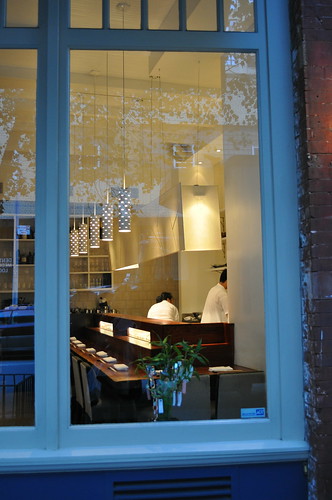
I called a month or so in advance for a reservation at the 15 East sushi bar (reservations are only available for the dining room at OpenTable.com) with seemingly no issues, except when I called back, the original mâitre d' made my reservation for the dining room. I would advise re-confirming a few days after you make the reservation to ensure that you'll be sitting at the sushi bar on your reservation date.

I read in many reviews of 15 East that sitting at the sushi bar with Chef Masato Shimizu, the executive sushi chef, was a MUST. I'm glad we decided to sit there. He was very knowledgeable and happy to answer any questions we had about the things we ordered that night. Also, being able to watch him prepare everything right before you was quite an experience (as you will see below). Before coming to New York, he apprenticed under Rikio Kugo, sushi master of Tokyo's Sukeroku. Once arriving to New York, he worked at Jewel Bako for 4 years before becoming executive sushi chef at 15 East.

The restaurant started us off with seasoned heirloom edamame. The seasoning was very different than the typical sea salt sprinkled on top, making for a nice unexpected surprise upfront.
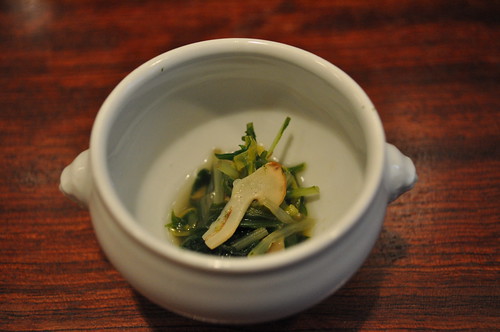
The amuse bouche of which we don't recall the contents/ingredients. I just remember it was soup-y, refreshing, and clean in flavor. When I asked Marcus about it, here was our conversation (pretty amusing if you ask me, haha):
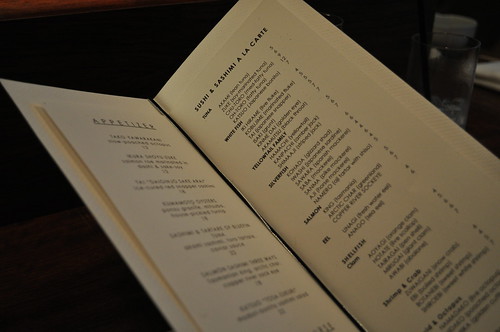
The sushi bar menu at 15 East. We opted to start with an appetizer (seen below) and the sushi omakase (i.e., the chef's choice of 10 pieces of sushi) for each of us. Omakase is Japanese for "entrust" where the meaning kindly extends to "entrusting" the sushi chef to prepare whatever he/she would like to make for you at a set price, where he/she is expected to serve you the best and highest quality items on the sushi bar menu. I would say that omakase is the Western equivalent of a tasting menu--meals/dishes that are predetermined by the chef--except the Japanese phrasing makes it more seemingly poetic.
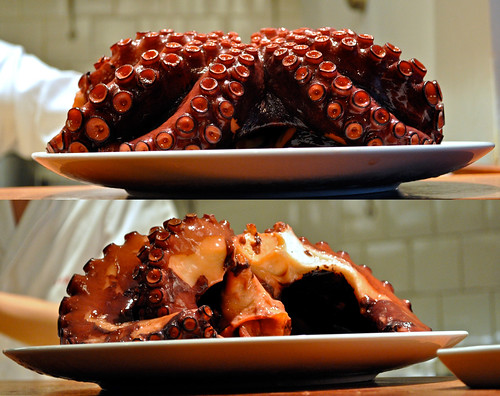
After reading several diners'/eaters' reviews, I gathered that Marcus and I HAD to order this appetizer at : the tako yamarakani, a slow-poached octopus. Chef Masa Shimizu showed us the entire tako from 15 East from which he slices off a few pieces from a tentacle to serve as an appetizer dish. This is the view from the front (top photograph) and the back (bottom). The sushi chef keeps the poached octopus in a pot of luke warm water behind the sushi bar.
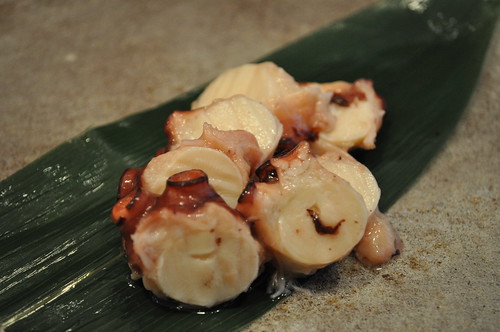
The tako yawarakani is plated on a thin square tile and served with some sea salt on the side for light coating. Usually, after having seen a mollusk like that, suction cups and all (is that even the correct term for those?), I would usually be a little reluctant to have eaten it right after. But in the spirit of everything (Marcus's birthday and being adventurous by ordering sushi omakase), my qualms somehow melted away, if they ever existed. With my chopsticks in hand, I tasted a piece of the tako with some sea salt. Oh, was it awesome! Perfectly moist and tender, light sea saltiness, not overcooked one bit. We barely needed to chew--it pretty much melted in our mouths. The slow-poaching preparation of the tako creates this amazing texture and flavor I have a hard time describing. Unlike typical cuttlefish/squid/octopus you may have had before, there was no chewiness to this octopus--it was smooth with a some structure. Before I could realize it, after some nearly orgasm-inducing bites, I went back for another piece, and it was all gone! So beware, this tako appetizer is addiction forming. I can almost guarantee once you've had this dish, you'll become a tako yawarakani enthusiast in no time!

This is Chef Masato's (everyone calls him Masa) work area--the sushi bar!
Each piece of sushi prepared by Chef Masato rests on a small mound of rice (called nigirizushi, Japanese for "hand-formed sushi") with a tiny bit of wasabi and soy sauce lightly brushed on the piece of raw fish. I usually try to avoid wasabi at all costs (somehow, most, if not all, mustards manage to ruin so many meals for me), but if it's prepared at a sushi bar, I don't seem to mind it. Maybe I'm a little elitist when it comes to sushi, so much that I prefer someone seasoning it with wasabi for me, haha.
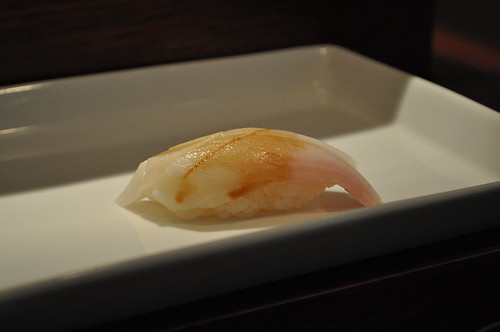
Hamachi no hara, yellowtail belly, was the first sushi in our sushi omakase. Very smooth, which made for a good start to our sushi tasting that night.
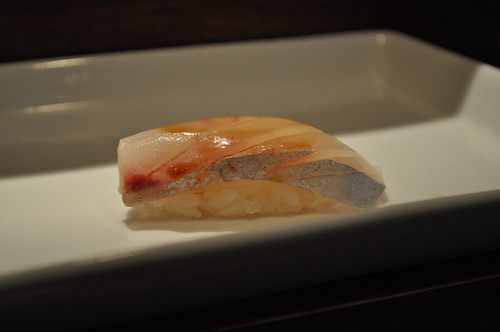
The next piece was shimaaji, striped jackfish, which we found to be very structured in texture--not as smooth as the others we had this same night, but still good.

The chef chose nodoguro, black-throat sea perch, as his third choice. Chef Masato told us that sea perch is very expensive in Japan (not so expensive here in the States) and that it is a very seasonal fish. Marcus and I were so preoccupied with trying to figure out what the chef said the fish was, that it kinda slipped our minds what this tasted like. We don't recall it tasting horrible, so Marcus said that this was pretty good.
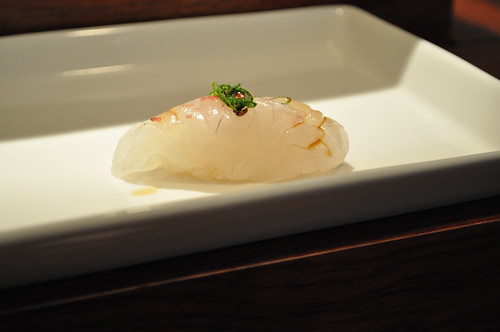
As our fourth piece of sushi, we were served the tai, Japanese red snapper, with pickled plum and scallions. Marcus found this to be soft like the chu-toro (see below), where the flavor was more full-bodied and sharper in taste.

I found this piece to have the most dimension and interesting preparation of all the sushi pieces we had. This is the kinme dai, golden eye snapper (kinme is Japanese for "gold eye", dai for "snapper" as seen above), with salt and lemon. The chef used a kitchen blow torch to toast the fish skin flavor, on the spot (see top part of photo)! The kinme dai had a really nice toasted flavor (and a tiny crunch) that paired well with the raw part of the fish. The salt and lemon accentuated this piece, too. Definitely one of my favorites of the night.

As one of my favorite items offered at the sushi bar, chu-toro (medium fatty tuna) is very rich in flavor and luscious in texture. This was Marcus's overall favorite of the night (one of my favorites of the night as well). The chu-toro just melted in our mouths (as the tako did). You can never go wrong with a quality piece of fatty tuna.

A nice follower to the chu-toro was oh-toro (i.e., tuna belly). It was very similar to the chu-toro, but slightly grainier and stringier. Not a favorite, but still savory.
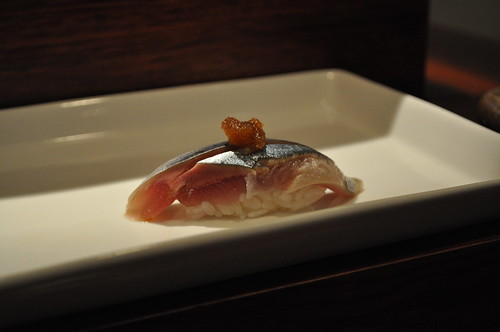
Next, the chef prepared sanma, pike mackerel, which he noted is a very seasonal offering at sushi bars. Marcus said this reminds him of albacore. I expected this to be a lot fishier tasting (which doesn't really bother me much) than it actually was (not fishy at all!) because of the iridescent/metallic skin. It had a smooth saltiness to it that I found to be great.
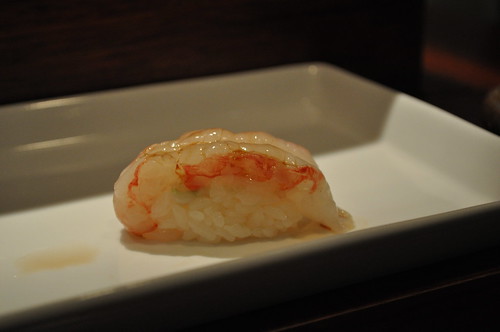
I was so glad we were able to have sweet shrimp during this visit, only because I wasn't sure when their prime season is usually over. This is the larger version of the standard sweet shrimp (amaebi) called botanebi. Subtly sweet and savory in flavor. I typically try to order this from a sushi menu if it's fresh and in season. Definitely a consistent favorite of mine.

The last piece served in our sushi omakase, this was the hotate--sea scallop seasoned with salt and yuzu zest, adding fresh, clean flavor (a nice plus!). Yuzu is an Asian citrus fruit that is very aromatic and has a similar tart flavor as that of grapefruit. The texture of the hotate was very different from the others, making it a nice piece to conclude our omakase and begin selecting a few more pieces of sushi we wanted to try or to repeat.
Marcus and I decided to repeat the chu-toro because we enjoyed it so much (not pictured twice, see photograph in original description above). I also wanted Marcus to try uni (sea urchin) as he'd never had it before, so Chef Masato recommended a tasting of uni from three different areas/regions.

The first uni (as well as Marcus's first!) was one from Hokkaido, Japan's most northern island. As I've read in an article from The New York Times, this region in Japan "commands the greatest prices" for sea urchins as it is the main uni-producing region. The texture was soft with a sea saltiness that didn't overpower the flavor from the uni, which was very rich in taste and creamy in texture. Definitely our favorite from the uni flight.

This second uni is from Kyuushu, Japan's most southwestern island, contrasting from previous from the northern island of Hokkaido. We found this uni to be less sea salty, smoother, and less grainy. The butteriness of the first uni definitely overshadows the texture of this piece.
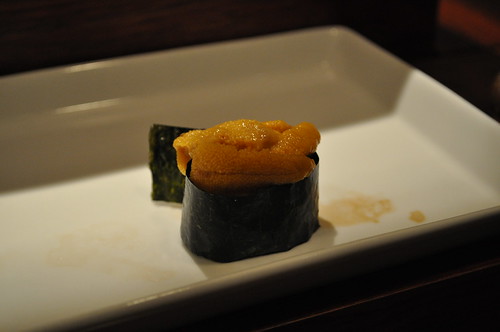
The last uni is from Maine. Neither Marcus nor I were really feeling this one. It was really, really grainy and liquidy (if that's even a word). It is interesting, however, that the previous article I mentioned earlier from The New York Times discusses how "more than 95 percent of all the sea urchins harvested in Maine are sent to Japan" because the uni from Maine "is almost identical to Japan's highly prized Hokkaido sea urchins, and some seafood industry experts have speculated that the Maine sea urchins are being passed off as the far more valuable Japanese variety once they arrive there." Maybe the article is outdated as it was published back in 1990, 10 years ago, but it still surprises me that the uni from Maine tasted the way it did after having been described as almost on par with, if not better than, the precious Hokkaido uni.
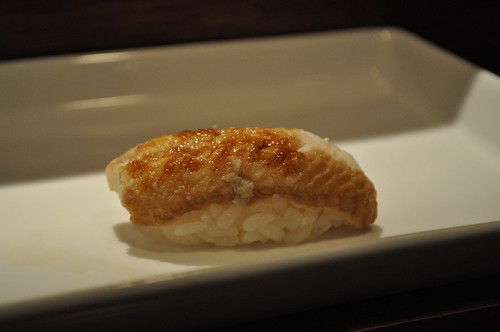
The last piece of the night (which happened to be on the house) was anago, sea eel, which the gentleman sitting at the next seat over from us at the sushi bar said was "Masa's specialty." The anago was totally boneless (a major plus) and the amount of glaze/sauce used was perfect--not overdone at all. Unagi glaze/sauce is typically prepared from a reduction of eel bone broth, soy sauce, rice wine and sugar and continuously flavored by dipping grilled eel into the sauce (also part of the grilled eel preparation process). No fishiness, not overcooked, and not overly marinated--I would recommend ordering anago from 15 East for sure!

15 East gave Marcus a really nice birthday dessert (candle and all)--it was a flourless bittersweet chocolate cake with baby strawberries and biscotti, drizzled with chocolate and caramel sauce. Yay for deliciousness! Happy birthday to Marcus :D!

Marcus ordered a trio of ice creams/sorbet (from left to right): sake ice cream, blood orange sorbet, and green tea ice cream. The sake flavor ice cream was had a very strong sake flavor (surprise, surprise)--it reminded me of a more pungent version of the ice cream we had in the dessert we had at wd~50. The blood orange was refreshing and tart. Green tea ice cream has always been a favorite dessert of mine at Japanese restaurants, and the one offered at 15 East was no exception. It was very authentic in flavor--bold, bittersweet, and creamy. So good!

This dessert was a little disappointing. I had the frozen apricot soufflé with pistachio cream and walnuts. I was expecting an actual soufflé (I admit I may have failed to read the "frozen" part), and what I got was a crumbly, cold dessert, swimming in green cream. There wasn't much flavor or dimension to the soufflé part. Though, I have to say, the walnuts were the best part of the dessert--slightly caramelized, lightly toasted, and crunchy.
Findings: I would say that the sushi omakase at 15 East rivals the one I had at Sushi Yasuda last year, but the tako appetizer won me over in the end. Chef Masato was very amiable and knowledgeable, which is important to be an entertaining and well-rounded sushi chef. As I've already said, I highly recommend getting reservations at the sushi bar--it's an experience in itself. As for what to order--you won't go wrong with the 10-piece sushi omakase that we ordered--the chef will select for you what the most in-season and high quality pieces he feels you should try! And remember to be adventurous when you go--especially if you're up for getting the tako yamarakani. I would say it's a "must-have"--along with the kinme dai (gold eye snapper), chu-toro (medium fatty tuna), anago (sea eel) and the uni from Hokkaido. That'll give you the best sampler, if you're going to do kitchen/dining room items. But if mollusks and raw fish aren't your thing, you should still give it a whirl--it may change your mind!
A very happy birthday to Marcus, again (two weeks later) :D! Hope you had as much of a lovely (and delicious) time as I had. Love you!
Price point: $12 for appetizer; $55 per person for 10-piece sushi omakase; $7-12 each for additional piece of sushi; $8-9 for dessert.
--October 2, 2010
15 East
15 East 15th Street
New York, NY 10003
http://www.15eastrestaurant.com/index_.html

Restaurant owners Marco Moreira and Jo-Ann Makovitzky came up with the concept of 15 East as a restaurant that "serves contemporary Japanese cuisine and traditional sushi in an elegant and comfortable setting." With a long history of experience and interest in Japanese cuisine from Sao Paulo, Brazil to New York City, Mr. Moreira's main focus for 15 East is "seasonality, unusual ingredients, and unique flavor and textural combinations."
I've recently started getting into trying Japanese restaurants in the city that specialize in its sashimi/sushi offerings (e.g., Sushi Yasuda, Tomoe Sushi, etc.). Having grown up in a small town in Jersey, the local Japanese restaurants were mostly acceptable (some became my regular stops during my cravings for Japanese food), others were never frequented again after a visit or two. For that reason, the variety of fish offered at sushi bars was very limited. Though, one of the few exceptions I've come across in Jersey that offers very authentic Japanese cuisine and has a vast variety of fish flown in from Japan weekly is Jo-Sho, a modest little Japanese restaurant located in Somerset, owned by a Japanese couple--the husband is the sushi chef, the wife the general manager. What my mom likes to say is if you see Japanese families eating at a Japanese restaurant, that's when you know there will be excellent Japanese food--which is the case with Jo-Sho. It wouldn't be out of the ordinary to hear and witness many exchanges of conversation in Japanese between patrons and the owners.
With the issue of limited selection in mind, ordering omakase (chef's choice menu) seems very farfetched when the menus were so limited to begin with, so it had never really occurred to me to ever order that way. I played around with the idea of omakase when I read Frank Bruni's restaurant review of his revisit to Sushi Yasuda. I experienced my first omakase meal during my visit to Sushi Yasuda last December with my best friend, Lisa. I knew from then on out that in order to experience the smorgasbord of raw fish offered in the higher end sushi bars of New York City, omakase would always be the way to go.

I called a month or so in advance for a reservation at the 15 East sushi bar (reservations are only available for the dining room at OpenTable.com) with seemingly no issues, except when I called back, the original mâitre d' made my reservation for the dining room. I would advise re-confirming a few days after you make the reservation to ensure that you'll be sitting at the sushi bar on your reservation date.

I read in many reviews of 15 East that sitting at the sushi bar with Chef Masato Shimizu, the executive sushi chef, was a MUST. I'm glad we decided to sit there. He was very knowledgeable and happy to answer any questions we had about the things we ordered that night. Also, being able to watch him prepare everything right before you was quite an experience (as you will see below). Before coming to New York, he apprenticed under Rikio Kugo, sushi master of Tokyo's Sukeroku. Once arriving to New York, he worked at Jewel Bako for 4 years before becoming executive sushi chef at 15 East.

The restaurant started us off with seasoned heirloom edamame. The seasoning was very different than the typical sea salt sprinkled on top, making for a nice unexpected surprise upfront.

The amuse bouche of which we don't recall the contents/ingredients. I just remember it was soup-y, refreshing, and clean in flavor. When I asked Marcus about it, here was our conversation (pretty amusing if you ask me, haha):
Stefie: Do you remember what the amuse bouche was?Oh well. Guess that goes unsolved in the vault of forgotten bites and meals.
Marcus: What the heck is that?
Stefie: You know, the thing they gave us after the edamame, before the octopus?
Marcus: Oh. What the heck was that thing? I can't remember.
Stefie: Haha, yea me neither. Any ideas?
Marcus: I don't even remember eating that. It must have been like, an afterthought bite.

The sushi bar menu at 15 East. We opted to start with an appetizer (seen below) and the sushi omakase (i.e., the chef's choice of 10 pieces of sushi) for each of us. Omakase is Japanese for "entrust" where the meaning kindly extends to "entrusting" the sushi chef to prepare whatever he/she would like to make for you at a set price, where he/she is expected to serve you the best and highest quality items on the sushi bar menu. I would say that omakase is the Western equivalent of a tasting menu--meals/dishes that are predetermined by the chef--except the Japanese phrasing makes it more seemingly poetic.

After reading several diners'/eaters' reviews, I gathered that Marcus and I HAD to order this appetizer at : the tako yamarakani, a slow-poached octopus. Chef Masa Shimizu showed us the entire tako from 15 East from which he slices off a few pieces from a tentacle to serve as an appetizer dish. This is the view from the front (top photograph) and the back (bottom). The sushi chef keeps the poached octopus in a pot of luke warm water behind the sushi bar.

The tako yawarakani is plated on a thin square tile and served with some sea salt on the side for light coating. Usually, after having seen a mollusk like that, suction cups and all (is that even the correct term for those?), I would usually be a little reluctant to have eaten it right after. But in the spirit of everything (Marcus's birthday and being adventurous by ordering sushi omakase), my qualms somehow melted away, if they ever existed. With my chopsticks in hand, I tasted a piece of the tako with some sea salt. Oh, was it awesome! Perfectly moist and tender, light sea saltiness, not overcooked one bit. We barely needed to chew--it pretty much melted in our mouths. The slow-poaching preparation of the tako creates this amazing texture and flavor I have a hard time describing. Unlike typical cuttlefish/squid/octopus you may have had before, there was no chewiness to this octopus--it was smooth with a some structure. Before I could realize it, after some nearly orgasm-inducing bites, I went back for another piece, and it was all gone! So beware, this tako appetizer is addiction forming. I can almost guarantee once you've had this dish, you'll become a tako yawarakani enthusiast in no time!

This is Chef Masato's (everyone calls him Masa) work area--the sushi bar!
Each piece of sushi prepared by Chef Masato rests on a small mound of rice (called nigirizushi, Japanese for "hand-formed sushi") with a tiny bit of wasabi and soy sauce lightly brushed on the piece of raw fish. I usually try to avoid wasabi at all costs (somehow, most, if not all, mustards manage to ruin so many meals for me), but if it's prepared at a sushi bar, I don't seem to mind it. Maybe I'm a little elitist when it comes to sushi, so much that I prefer someone seasoning it with wasabi for me, haha.

Hamachi no hara, yellowtail belly, was the first sushi in our sushi omakase. Very smooth, which made for a good start to our sushi tasting that night.

The next piece was shimaaji, striped jackfish, which we found to be very structured in texture--not as smooth as the others we had this same night, but still good.

The chef chose nodoguro, black-throat sea perch, as his third choice. Chef Masato told us that sea perch is very expensive in Japan (not so expensive here in the States) and that it is a very seasonal fish. Marcus and I were so preoccupied with trying to figure out what the chef said the fish was, that it kinda slipped our minds what this tasted like. We don't recall it tasting horrible, so Marcus said that this was pretty good.

As our fourth piece of sushi, we were served the tai, Japanese red snapper, with pickled plum and scallions. Marcus found this to be soft like the chu-toro (see below), where the flavor was more full-bodied and sharper in taste.

I found this piece to have the most dimension and interesting preparation of all the sushi pieces we had. This is the kinme dai, golden eye snapper (kinme is Japanese for "gold eye", dai for "snapper" as seen above), with salt and lemon. The chef used a kitchen blow torch to toast the fish skin flavor, on the spot (see top part of photo)! The kinme dai had a really nice toasted flavor (and a tiny crunch) that paired well with the raw part of the fish. The salt and lemon accentuated this piece, too. Definitely one of my favorites of the night.

As one of my favorite items offered at the sushi bar, chu-toro (medium fatty tuna) is very rich in flavor and luscious in texture. This was Marcus's overall favorite of the night (one of my favorites of the night as well). The chu-toro just melted in our mouths (as the tako did). You can never go wrong with a quality piece of fatty tuna.

A nice follower to the chu-toro was oh-toro (i.e., tuna belly). It was very similar to the chu-toro, but slightly grainier and stringier. Not a favorite, but still savory.

Next, the chef prepared sanma, pike mackerel, which he noted is a very seasonal offering at sushi bars. Marcus said this reminds him of albacore. I expected this to be a lot fishier tasting (which doesn't really bother me much) than it actually was (not fishy at all!) because of the iridescent/metallic skin. It had a smooth saltiness to it that I found to be great.

I was so glad we were able to have sweet shrimp during this visit, only because I wasn't sure when their prime season is usually over. This is the larger version of the standard sweet shrimp (amaebi) called botanebi. Subtly sweet and savory in flavor. I typically try to order this from a sushi menu if it's fresh and in season. Definitely a consistent favorite of mine.

The last piece served in our sushi omakase, this was the hotate--sea scallop seasoned with salt and yuzu zest, adding fresh, clean flavor (a nice plus!). Yuzu is an Asian citrus fruit that is very aromatic and has a similar tart flavor as that of grapefruit. The texture of the hotate was very different from the others, making it a nice piece to conclude our omakase and begin selecting a few more pieces of sushi we wanted to try or to repeat.
Marcus and I decided to repeat the chu-toro because we enjoyed it so much (not pictured twice, see photograph in original description above). I also wanted Marcus to try uni (sea urchin) as he'd never had it before, so Chef Masato recommended a tasting of uni from three different areas/regions.

The first uni (as well as Marcus's first!) was one from Hokkaido, Japan's most northern island. As I've read in an article from The New York Times, this region in Japan "commands the greatest prices" for sea urchins as it is the main uni-producing region. The texture was soft with a sea saltiness that didn't overpower the flavor from the uni, which was very rich in taste and creamy in texture. Definitely our favorite from the uni flight.

This second uni is from Kyuushu, Japan's most southwestern island, contrasting from previous from the northern island of Hokkaido. We found this uni to be less sea salty, smoother, and less grainy. The butteriness of the first uni definitely overshadows the texture of this piece.

The last uni is from Maine. Neither Marcus nor I were really feeling this one. It was really, really grainy and liquidy (if that's even a word). It is interesting, however, that the previous article I mentioned earlier from The New York Times discusses how "more than 95 percent of all the sea urchins harvested in Maine are sent to Japan" because the uni from Maine "is almost identical to Japan's highly prized Hokkaido sea urchins, and some seafood industry experts have speculated that the Maine sea urchins are being passed off as the far more valuable Japanese variety once they arrive there." Maybe the article is outdated as it was published back in 1990, 10 years ago, but it still surprises me that the uni from Maine tasted the way it did after having been described as almost on par with, if not better than, the precious Hokkaido uni.

The last piece of the night (which happened to be on the house) was anago, sea eel, which the gentleman sitting at the next seat over from us at the sushi bar said was "Masa's specialty." The anago was totally boneless (a major plus) and the amount of glaze/sauce used was perfect--not overdone at all. Unagi glaze/sauce is typically prepared from a reduction of eel bone broth, soy sauce, rice wine and sugar and continuously flavored by dipping grilled eel into the sauce (also part of the grilled eel preparation process). No fishiness, not overcooked, and not overly marinated--I would recommend ordering anago from 15 East for sure!

15 East gave Marcus a really nice birthday dessert (candle and all)--it was a flourless bittersweet chocolate cake with baby strawberries and biscotti, drizzled with chocolate and caramel sauce. Yay for deliciousness! Happy birthday to Marcus :D!

Marcus ordered a trio of ice creams/sorbet (from left to right): sake ice cream, blood orange sorbet, and green tea ice cream. The sake flavor ice cream was had a very strong sake flavor (surprise, surprise)--it reminded me of a more pungent version of the ice cream we had in the dessert we had at wd~50. The blood orange was refreshing and tart. Green tea ice cream has always been a favorite dessert of mine at Japanese restaurants, and the one offered at 15 East was no exception. It was very authentic in flavor--bold, bittersweet, and creamy. So good!

This dessert was a little disappointing. I had the frozen apricot soufflé with pistachio cream and walnuts. I was expecting an actual soufflé (I admit I may have failed to read the "frozen" part), and what I got was a crumbly, cold dessert, swimming in green cream. There wasn't much flavor or dimension to the soufflé part. Though, I have to say, the walnuts were the best part of the dessert--slightly caramelized, lightly toasted, and crunchy.
Findings: I would say that the sushi omakase at 15 East rivals the one I had at Sushi Yasuda last year, but the tako appetizer won me over in the end. Chef Masato was very amiable and knowledgeable, which is important to be an entertaining and well-rounded sushi chef. As I've already said, I highly recommend getting reservations at the sushi bar--it's an experience in itself. As for what to order--you won't go wrong with the 10-piece sushi omakase that we ordered--the chef will select for you what the most in-season and high quality pieces he feels you should try! And remember to be adventurous when you go--especially if you're up for getting the tako yamarakani. I would say it's a "must-have"--along with the kinme dai (gold eye snapper), chu-toro (medium fatty tuna), anago (sea eel) and the uni from Hokkaido. That'll give you the best sampler, if you're going to do kitchen/dining room items. But if mollusks and raw fish aren't your thing, you should still give it a whirl--it may change your mind!
A very happy birthday to Marcus, again (two weeks later) :D! Hope you had as much of a lovely (and delicious) time as I had. Love you!
Price point: $12 for appetizer; $55 per person for 10-piece sushi omakase; $7-12 each for additional piece of sushi; $8-9 for dessert.
--October 2, 2010
15 East
15 East 15th Street
New York, NY 10003
http://www.15eastrestaurant.com/index_.html
Thursday, October 14, 2010
Q&A | Erin
My bestest friend from before we could even talk, Erin and I like to frequent the latest trendy places to eat (as of late--Megu Tribeca, Tao, Dos Caminos). We also like to go to Saint Marks Place or Nolita for late night grub (nothing like a bowl of soup noodles, chicken-don, and bibimbap to end a night of happy drunkenness) like Kenka and Jup She. She's the one who introduced me to the French macaron (and I haven't been able to stop thanking her since with boxes of macarons from all over Manhattan). A year or so ago, we tried to make French macarons from scratch, which was pretty much a complete and utter disaster, but we had fun anyway! We've been morsel marauders all our lives (she's my Taco Bell compadre for life, but nobody is supposed to know we're regulars there, so shhh!), and I look forward to more (mis)adventures with her! Thanks again for participating, Erin! Love ya!
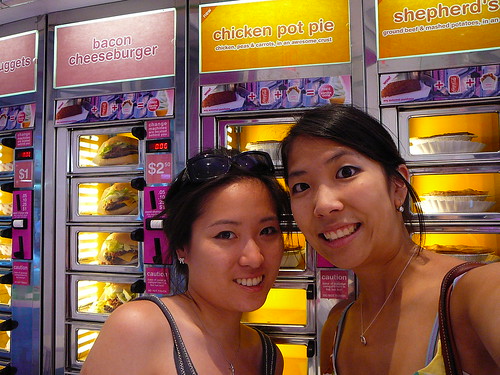
Erin and me at Bamn!, a now-closed retro automat located at Saint Marks Place.
NAME
Erin
CURRENT CITY
New York, NY
FAVORITE ALL-TIME RESTAURANT
Megu Tribeca, Wolfgang Steak House Tribeca
MOST REGULARLY FREQUENTED SPOT(S)
Big Wing Wong, Taco Bell, Butter, Agozar!, Wonjo, Wolfgang Steak House
DRINK OF CHOICE
I keep it classy: Starbucks cinnamon dolce lattés, cosmopolitan martinis, and of course my choice beer, a nice cold Corona.
SOMETHING YOU SECRETLY INDULGE
STARBUCKS LATTÉS, but I doubt it's much of a secret anymore. I go everyday.
DISH YOU MOST ENJOY PREPARING
fried rice with random veggies for a group of friends, especially after a long/fun night of going out :)
THE HOMEMADE DISH YOU ALWAYS LONG FOR
My mom makes this great dish with tomato, steak, egg... I always crave it when I'm home, and of course, it goes amazing with my favorite food I cannot live without: white rice. I'm pretty easy to please, anything with steak, egg or rice will most likely satisfy me.
GASTRONOMIC GETAWAY/ADVENTURE OF CHOICE
Completed: Rome
Yet to come: Thailand
CULINARY ICONS
Buddy Valastro
MEAL YOU WISH YOU CAN REPEAT BUT SOMEHOW CANNOT
I had really fabulous foie gras in Paris, in the Montparnasse area... the way the foie gras melted in my mouth is nothing like it is in the United States. There are some neighborhood gems here which serve awesome foie gras, but nothing beats the real deal in Paris.
ABSOLUTE "CAN'T-STANDS"
mushrooms, things with teeth, peanut butter, and scallion in my soup noodles.
FAVORITE DESSERT OF ALL TIME
This is a hard one... it's a rock-paper-scissors situation between apple strudels, crème brûlée, and soufflés.
FAVORITE COOKBOOK/COFFEE TABLE BOOK
Christian Dior's The Little Dictionary of Fashion
CULINARY WORDS THAT NEVER LOSE THEIR PANACHE
C'est juste magnifique, YUM!
FOOD BLOG(S) YOU JUST CAN'T GET ENOUGH OF
Four Tines!

Erin and me at Bamn!, a now-closed retro automat located at Saint Marks Place.
NAME
Erin
CURRENT CITY
New York, NY
FAVORITE ALL-TIME RESTAURANT
Megu Tribeca, Wolfgang Steak House Tribeca
MOST REGULARLY FREQUENTED SPOT(S)
Big Wing Wong, Taco Bell, Butter, Agozar!, Wonjo, Wolfgang Steak House
DRINK OF CHOICE
I keep it classy: Starbucks cinnamon dolce lattés, cosmopolitan martinis, and of course my choice beer, a nice cold Corona.
SOMETHING YOU SECRETLY INDULGE
STARBUCKS LATTÉS, but I doubt it's much of a secret anymore. I go everyday.
DISH YOU MOST ENJOY PREPARING
fried rice with random veggies for a group of friends, especially after a long/fun night of going out :)
THE HOMEMADE DISH YOU ALWAYS LONG FOR
My mom makes this great dish with tomato, steak, egg... I always crave it when I'm home, and of course, it goes amazing with my favorite food I cannot live without: white rice. I'm pretty easy to please, anything with steak, egg or rice will most likely satisfy me.
GASTRONOMIC GETAWAY/ADVENTURE OF CHOICE
Completed: Rome
Yet to come: Thailand
CULINARY ICONS
Buddy Valastro
MEAL YOU WISH YOU CAN REPEAT BUT SOMEHOW CANNOT
I had really fabulous foie gras in Paris, in the Montparnasse area... the way the foie gras melted in my mouth is nothing like it is in the United States. There are some neighborhood gems here which serve awesome foie gras, but nothing beats the real deal in Paris.
ABSOLUTE "CAN'T-STANDS"
mushrooms, things with teeth, peanut butter, and scallion in my soup noodles.
FAVORITE DESSERT OF ALL TIME
This is a hard one... it's a rock-paper-scissors situation between apple strudels, crème brûlée, and soufflés.
FAVORITE COOKBOOK/COFFEE TABLE BOOK
Christian Dior's The Little Dictionary of Fashion
CULINARY WORDS THAT NEVER LOSE THEIR PANACHE
C'est juste magnifique, YUM!
FOOD BLOG(S) YOU JUST CAN'T GET ENOUGH OF
Four Tines!
Tags:
2010,
food for thought,
Q+A,
QA
Monday, October 11, 2010
Dinner | Marea, i
Three Thursdays ago, Linda and I made plans for dinner at Marea, Chef Michael White's coastal Italian seafood venture with restauranteur, Chris Cannon. This is their third collaboration together, embodying the influences of ingredients from the four bodies of water surrounding the peninsula of Italy. As Marea's menu reads like "a study of the sea", its fish is "sourced from both the Mediterranean and waters worldwide", aiming to add to the restaurant's authenticity.

I love the cerulean blue used in its restaurant awnings outside as well as on its business cards. Very suggestive of the sea!
I had originally heard about Marea from last year's James Beard Foundation award nominations. It was nominated (subsequently winning) within the Best New Restaurant category, for which the award is given to "a restaurant opened in 2009 that already displays excellence in food, beverage, and services and is likely to have a significant impact on the industry in years to come". Chef Michael White was also nominated within the Best Chef: New York City category, citing Marea as well. I figured there might be something to explore and taste, so I told Linda about it, and she was in! Now, having had the MICHELIN inspectors announce that Marea has earned its second MICHELIN star (note this happened after our visit), it sounds like the restaurant is movin' on up in the foodie world! Now, having had the MICHELIN inspectors announce that Marea has earned its second MICHELIN star (note this was announced a couple weeks after our visit), it sounds like the restaurant is movin' on up in the food world!

How might you ask, did we get a reservation, only with less than a weeks' notice? Easy! As I've learned from the reservation pro (aka Linda), many restaurants serve its full menu at the bar (as seen in our adventure at Maialino). I checked Marea’s website to see if there was dining available at the bar—somewhere, it briefly mentioned that there was. Just to make sure, I called the maître d’ and inquired whether the restaurant offered dining at the bar, which she confirmed it did. She did also mention the restaurant’s policy regarding bar room dining was “first come, first serve”. Not a problem at all, as Linda and I planned for dinner around 6:30 PM.
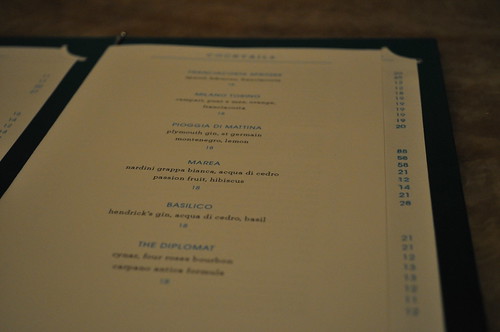
Cocktail menu at Marea. I decided on the Marea cocktail hoping it was some kind of signature drink concoction of the restaurant, and also because I usually like any kind of passion fruit twist on a cocktail.

Hibiscus placed in my glass in the Marea cocktail I ordered.
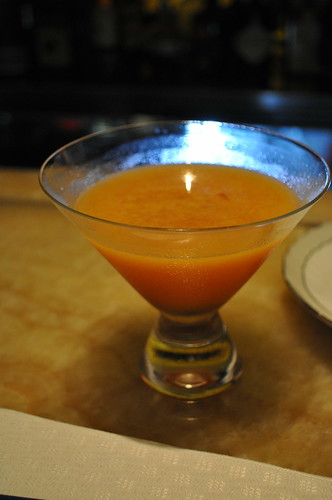
The Marea cocktail consisted of Nardini grappa bianca (traditional-style grappa that has a fruity flavor with citrus-oil and fig aromas), acqua di cedro (a citron-infused liqueur), passion fruit, and hibiscus. This was REALLY good. The only thing I couldn't put my finger on was there was a slight chocolate-y / sambuca-like aftertaste--it may have been the passion fruit. A little bizarre if I do say so myself, but great cocktail nevertheless!
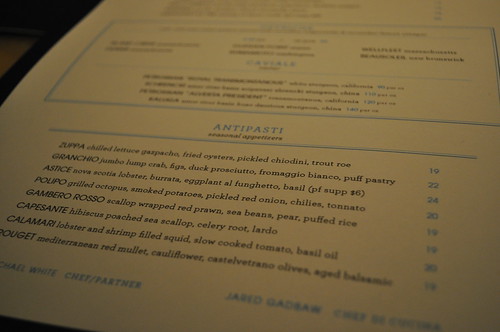
I noticed the menu is laid out similarly to the one at Maialino. The combination of black text on bone-colored paper with blue as an auxiliary color.

Inside Marea. I love the understated elegance of the restaurant's space. It reminds me of a seafood brasserie I've been to a few times in SoHo called Lure Fishbar. As Frank Bruni put so well, Lure's décor "cunningly evokes the interior of a supersize yacht". While Marea may not blatantly scream yacht, it somehow suggests a sophisticated maritime and nautical feel, which is fitting for its coastal cuisine offerings. It might be the subdued earth tones against the dark hardwood that creates that effect. Notice the curved glass towards the back--it's actually a raw bar where patrons can sit and dine and admire the crudo al taglio (Italian for "raw cut") seafood.
Before I get into what we ate, etc., I wanted to delve into explaining what a traditional Italian menu structure is like. The structure consists of four "dish courses"--I'm excluding any apertivos or digestivos. The first course is the antipasto, literally Italian for "before the meal, which is usually a cold or hot appetizer (seen below as granchio and astice). This course is followed by the primo, Italian for "first course", consisting of a hot dish, typically a pasta, risotto, polenta, gnocchi, or soup. This is the main source of carbohydrates during the course of the entire meal. After the primo is the secondo, Italian for "second course", the main dish consisting of seafood or meat. Many times, the secondo is paired with a contorno (literally in Italian for "contour", which I extend to be a "contour" surrounding a dish), a side dish consisting of a salad or cooked vegetables. The dolce (Italian for "sweet") is the last dish, punctuating the entire meal--the dessert.
As you can see from the rest of this post, Linda and I skipped the secondo, making our primo our main dish for the night, below.

My first course, an antipasta, was the granchio (Italian for "crab"), which had jumbo lump crab served with figs, duck prosciutto atop, fromaggio bianco, and puff pastry at the bottom. I was a bit apprehensive about the fromaggio bianco, because as you know, cheese and I don’t usually see eye-to-eye in most instances. However, I figured the lovely combination of figs (I’m a sucker for seedy fruits of the like—strawberries, kiwi, etc.), duck (in prosciutto form, no less!), and lump crab would more than compensate for some measly cheese.
And folks, Chef Michael White did not disappoint! The cold, sea-freshness of the crab and the saltiness of the thin slices of cured duck together with the fresh fig preserves served for a great starter dish. The presentation of the puff pastry was unexpected. I imagined the entire dish to be enveloped somehow in puff pastry “purse”, like a quiche. As you can see in the photograph above, the bottom layer of the dish was the puff pastry, in rectangular form, the presentation typical for canapés--pieces of puff pastry served with a savory topping (in this case, the combination of crab, figs, and duck—very savory, indeed). What I found to be interesting is that canapé is French for “couch”, which can be figuratively extended in the sense that the puff pastry is the “couch” on which to place “toppings”. On another note, the fromaggio cheese was served on the side, so no issues there!

Linda went with the astice (Italian for "lobster"), which was Nova Scotia lobster with burrata (a fresh Italian cheese made with mozzarella and cream--making for a very soft texture--usually served at room temperature), eggplant al funghetto, and basil. Lobster was well-prepared—perfectly tender, served cold. I love the colors presented in this dish also--very fresh and clean.
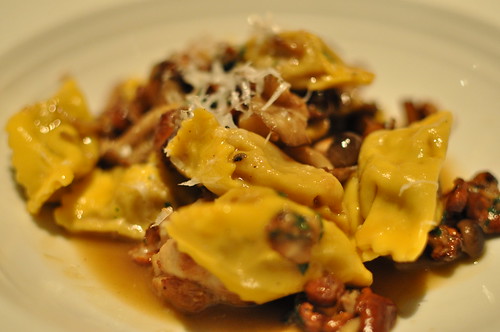
I think I've been on an agnolotti kick having since been to Maialino as I couldn't resist ordering the agnolotti, which had veal ravioli, sweetbreads, and funghi. This was from the pasta fatta in casa (i.e., homemade pasta--subtitled in the menu as "pasta made by hand in house") section of the menu, from the category altre pasta (i.e., other pasta, which differentiates from its primi di mare (i.e., first course subdivision of seafood). Very hearty ingredients (resonating fall/winter flavors) that made for a very richly tasting pasta dish. I always look forward to seeing veal, sweetbreads, and mushrooms in any dish--so when they're combined so nicely in a dish like this, what's there not to like? I wasn't disappointed, but I wasn't overwhelmingly wow-ed, either. I think my issue here is that I should have ordered a dish with seafood as an ingredient at an Italian restaurant specializing in coastal Italian cuisine (I compensated for this during my subsequent visit a couple weeks later--post to follow soon)!
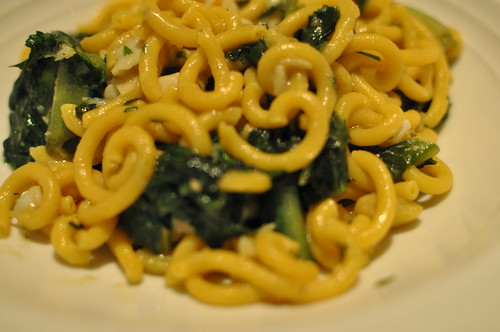
Linda had the gramigna with housemade bacala (a salted cod) and fave e cicoria (beans and chicory). Gramigna is a pasta variety that is a thin, short, curled strand of pasta. I found the bite I had to be quite flavorful, with a nice amount of saltiness to match. Very hearty dish also that need not include any hearty red meats, which is refreshing to taste.

What a nice touch to the dolci menu--Work is the meat of life. Pleasure, the dessert. Very clever!

I ordered the gianduja with cocoa nib crema, hazelnuts, chocolate, and fior di latte gelato. If I ever have issues deciding which dessert to select from a menu, chances are if there are hazelnuts in the picture, that will be my final answer, usually without question. Also, gianduja is a European-style of chocolate made from chocolate and nut paste. Most commonly used paste is made from hazelnut, but almond paste can also be used, so the actual hazelnuts added a fresh touch. The cocoa nibs added a nice crunch to the gelato and gianduja combination. Very delightful dessert!

Linda had the budino di riso--a spiced rice pudding with slices of stone fruit, amaretti crumble, and plum sorbet. The poached stone fruits were layered in a wall around the spiced rice pudding. I love the added spice to the rice pudding, kind of giving an autumnal feel to the dessert. For those who may find chocolate too rich in the desserts of fine dining, this is a great non-chocolate dessert to have. Linda's a big fan of rice pudding, so this was right up her alley!
Price point: $18 for the cocktail; $22-24 for each antipasta; $27-29 for each primo/pasta fatta in casa; $13-14 for each dolce.
--September 29, 2010
Marea
240 Central Park South
New York, NY 10019
http://www.marea-nyc.com/home.html

I love the cerulean blue used in its restaurant awnings outside as well as on its business cards. Very suggestive of the sea!
I had originally heard about Marea from last year's James Beard Foundation award nominations. It was nominated (subsequently winning) within the Best New Restaurant category, for which the award is given to "a restaurant opened in 2009 that already displays excellence in food, beverage, and services and is likely to have a significant impact on the industry in years to come". Chef Michael White was also nominated within the Best Chef: New York City category, citing Marea as well. I figured there might be something to explore and taste, so I told Linda about it, and she was in! Now, having had the MICHELIN inspectors announce that Marea has earned its second MICHELIN star (note this happened after our visit), it sounds like the restaurant is movin' on up in the foodie world! Now, having had the MICHELIN inspectors announce that Marea has earned its second MICHELIN star (note this was announced a couple weeks after our visit), it sounds like the restaurant is movin' on up in the food world!

How might you ask, did we get a reservation, only with less than a weeks' notice? Easy! As I've learned from the reservation pro (aka Linda), many restaurants serve its full menu at the bar (as seen in our adventure at Maialino). I checked Marea’s website to see if there was dining available at the bar—somewhere, it briefly mentioned that there was. Just to make sure, I called the maître d’ and inquired whether the restaurant offered dining at the bar, which she confirmed it did. She did also mention the restaurant’s policy regarding bar room dining was “first come, first serve”. Not a problem at all, as Linda and I planned for dinner around 6:30 PM.

Cocktail menu at Marea. I decided on the Marea cocktail hoping it was some kind of signature drink concoction of the restaurant, and also because I usually like any kind of passion fruit twist on a cocktail.

Hibiscus placed in my glass in the Marea cocktail I ordered.

The Marea cocktail consisted of Nardini grappa bianca (traditional-style grappa that has a fruity flavor with citrus-oil and fig aromas), acqua di cedro (a citron-infused liqueur), passion fruit, and hibiscus. This was REALLY good. The only thing I couldn't put my finger on was there was a slight chocolate-y / sambuca-like aftertaste--it may have been the passion fruit. A little bizarre if I do say so myself, but great cocktail nevertheless!

I noticed the menu is laid out similarly to the one at Maialino. The combination of black text on bone-colored paper with blue as an auxiliary color.

Inside Marea. I love the understated elegance of the restaurant's space. It reminds me of a seafood brasserie I've been to a few times in SoHo called Lure Fishbar. As Frank Bruni put so well, Lure's décor "cunningly evokes the interior of a supersize yacht". While Marea may not blatantly scream yacht, it somehow suggests a sophisticated maritime and nautical feel, which is fitting for its coastal cuisine offerings. It might be the subdued earth tones against the dark hardwood that creates that effect. Notice the curved glass towards the back--it's actually a raw bar where patrons can sit and dine and admire the crudo al taglio (Italian for "raw cut") seafood.
Before I get into what we ate, etc., I wanted to delve into explaining what a traditional Italian menu structure is like. The structure consists of four "dish courses"--I'm excluding any apertivos or digestivos. The first course is the antipasto, literally Italian for "before the meal, which is usually a cold or hot appetizer (seen below as granchio and astice). This course is followed by the primo, Italian for "first course", consisting of a hot dish, typically a pasta, risotto, polenta, gnocchi, or soup. This is the main source of carbohydrates during the course of the entire meal. After the primo is the secondo, Italian for "second course", the main dish consisting of seafood or meat. Many times, the secondo is paired with a contorno (literally in Italian for "contour", which I extend to be a "contour" surrounding a dish), a side dish consisting of a salad or cooked vegetables. The dolce (Italian for "sweet") is the last dish, punctuating the entire meal--the dessert.
As you can see from the rest of this post, Linda and I skipped the secondo, making our primo our main dish for the night, below.

My first course, an antipasta, was the granchio (Italian for "crab"), which had jumbo lump crab served with figs, duck prosciutto atop, fromaggio bianco, and puff pastry at the bottom. I was a bit apprehensive about the fromaggio bianco, because as you know, cheese and I don’t usually see eye-to-eye in most instances. However, I figured the lovely combination of figs (I’m a sucker for seedy fruits of the like—strawberries, kiwi, etc.), duck (in prosciutto form, no less!), and lump crab would more than compensate for some measly cheese.
And folks, Chef Michael White did not disappoint! The cold, sea-freshness of the crab and the saltiness of the thin slices of cured duck together with the fresh fig preserves served for a great starter dish. The presentation of the puff pastry was unexpected. I imagined the entire dish to be enveloped somehow in puff pastry “purse”, like a quiche. As you can see in the photograph above, the bottom layer of the dish was the puff pastry, in rectangular form, the presentation typical for canapés--pieces of puff pastry served with a savory topping (in this case, the combination of crab, figs, and duck—very savory, indeed). What I found to be interesting is that canapé is French for “couch”, which can be figuratively extended in the sense that the puff pastry is the “couch” on which to place “toppings”. On another note, the fromaggio cheese was served on the side, so no issues there!

Linda went with the astice (Italian for "lobster"), which was Nova Scotia lobster with burrata (a fresh Italian cheese made with mozzarella and cream--making for a very soft texture--usually served at room temperature), eggplant al funghetto, and basil. Lobster was well-prepared—perfectly tender, served cold. I love the colors presented in this dish also--very fresh and clean.

I think I've been on an agnolotti kick having since been to Maialino as I couldn't resist ordering the agnolotti, which had veal ravioli, sweetbreads, and funghi. This was from the pasta fatta in casa (i.e., homemade pasta--subtitled in the menu as "pasta made by hand in house") section of the menu, from the category altre pasta (i.e., other pasta, which differentiates from its primi di mare (i.e., first course subdivision of seafood). Very hearty ingredients (resonating fall/winter flavors) that made for a very richly tasting pasta dish. I always look forward to seeing veal, sweetbreads, and mushrooms in any dish--so when they're combined so nicely in a dish like this, what's there not to like? I wasn't disappointed, but I wasn't overwhelmingly wow-ed, either. I think my issue here is that I should have ordered a dish with seafood as an ingredient at an Italian restaurant specializing in coastal Italian cuisine (I compensated for this during my subsequent visit a couple weeks later--post to follow soon)!

Linda had the gramigna with housemade bacala (a salted cod) and fave e cicoria (beans and chicory). Gramigna is a pasta variety that is a thin, short, curled strand of pasta. I found the bite I had to be quite flavorful, with a nice amount of saltiness to match. Very hearty dish also that need not include any hearty red meats, which is refreshing to taste.

What a nice touch to the dolci menu--Work is the meat of life. Pleasure, the dessert. Very clever!

I ordered the gianduja with cocoa nib crema, hazelnuts, chocolate, and fior di latte gelato. If I ever have issues deciding which dessert to select from a menu, chances are if there are hazelnuts in the picture, that will be my final answer, usually without question. Also, gianduja is a European-style of chocolate made from chocolate and nut paste. Most commonly used paste is made from hazelnut, but almond paste can also be used, so the actual hazelnuts added a fresh touch. The cocoa nibs added a nice crunch to the gelato and gianduja combination. Very delightful dessert!

Linda had the budino di riso--a spiced rice pudding with slices of stone fruit, amaretti crumble, and plum sorbet. The poached stone fruits were layered in a wall around the spiced rice pudding. I love the added spice to the rice pudding, kind of giving an autumnal feel to the dessert. For those who may find chocolate too rich in the desserts of fine dining, this is a great non-chocolate dessert to have. Linda's a big fan of rice pudding, so this was right up her alley!
Findings: I really like the classic menu structure at Marea--it certainly adds to the restaurant's authenticity of going back to regional Italian cuisine. The restaurant's ambiance is also something I really enjoyed--I enjoy things more when they're understated, subtle, and minimalist in nature. The same goes for the restaurant's dishes--very flavorful with simplicity and looking to classical regional rudimentary cooking, which isn't to say the creativity isn't there. The granchia is a great example--presentation and combination wise! I really enjoyed our experience eating at the bar--it made for great conversation, without feeling too stuffy or overdone. I really recommend ordering seafood-focused dishes (as it is the restaurant's focus/specialty)--not to say that carne is poorly executed. I think it's kind of what Marcus said in his Argo Tea post: that ordering non-seafood items at a seafood restaurant is "almost as sad as watching the crazed, misguided man who sits down at a Japanese sushi restaurant intending to order a hamburger." No worries--I learned my lesson. Please look for my upcoming post about my most recent visit to Marea and the primo I ordered to mark the best of both worlds of land and sea. Nevertheless, great conversation mixed with Italian red wine and solid Italian cuisine makes Marea a lovely place to catch up with friends and nourish our stomachs well.
Price point: $18 for the cocktail; $22-24 for each antipasta; $27-29 for each primo/pasta fatta in casa; $13-14 for each dolce.
--September 29, 2010
Marea
240 Central Park South
New York, NY 10019
http://www.marea-nyc.com/home.html
Sunday, October 10, 2010
Toasts | Kai Ma's 50th Birthday
Just wanted to wish my godmother (I call her "Kai Ma" in Cantonese) a very, very happy fiftieth birthday today on 10.10.10! She's one of the most generous, hospitable, encouraging, and kindest people I know, and I'm very thankful to have known her my whole life! Happy birthday, Kai Ma--so glad my mom and I could come all the way to Chicago to celebrate it with you! Love you always!

From left to right: me, my mom, Kai Ma, Laura (my godsister), and Kai Yeh (my godfather--the photographer here!) celebrating Kai Ma's 50th birthday at Grant Achatz's Alinea in the Lincoln Park neighborhood of Chicago! Blog post about this gastronomic adventure is on its way, I promise!
From left to right: me, Laura, Kai Ma's mom, Kai Ma, my mom, and Kai Yeh picking up the whole roast pig and soy sauce chickens from Chinatown's BBQ King House in Chicago earlier today for her big celebration tonight! From what I've tasted, both are very delicious! The Chinese believe that serving a whole roast pig is a good omen--the harmony of the "whole". Another good omen is to serve whole chickens, which symbolizes a proper beginning and end to the year as well as the wholeness of life on earth.
Happy Birthday, Kai Ma :] excited to celebrate with you, your family, and your close friends tonight!
Subscribe to:
Posts (Atom)

